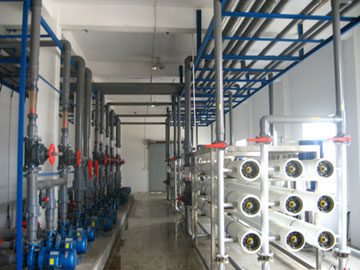

 |
|
|
|||||||||
|
|
|||||||||
|
|
 |

Salt free effluent with Reverse Osmosis treatment |
Effluent treatment & recycling technologies
Industries are facing a significant increase in effluent discharge costs, which are based on COD, BOD, suspended solids and volume. Membrane bioreactor (MBR) technology can be considered as BAT (Best Available Technology) to achieve stringent effluent consent and to reduce pollution. MBR treatment provides for an excellent effluent quality with high reduction in COD, BOD and SS concentrations, which enables the tannery to reduce discharge costs and to achieve full compliance. The MBR permeate can be polished by Reverse Osmosis, which enables process water re-use of 'soft' water, which can reduce the usage of process chemicals in the tannery. |
 |
 |
Overview of the Technology
Membrane bioreactors (MBR) are considered as an emerging technology with major potential in wastewater treatment. MBR technology provides a relatively compact alternative to conventional effluent treatment options, producing very little excess sludge and a high quality effluent even at high and varying organic loading rates. The substantial reductions in COD, BOD and suspended solids offers greatly reduced effluent charges, with the potential to discharge to river or even the recycling of clarified, bacteria-free water.
A major benefit of the MBR is the total retention of all microorganisms, with greatly increased sludge ages compared to conventional biological plant. This enables the specialist biomass, often the slow growing organisms, to develop and to degrade the specific organic compounds. The applied ultrafiltration membranes are excellent for the separation of emulsions and proteins from the wastewater which retain the attached problem compounds in the MBR for extended biodegradation. W2O has developed a relatively low cost and compact membrane bioreactor (MBR) process which has been successfully applied for tannery effluent treatment. The combined bioreactor process MBR applied for tannery wastewater treatment demonstrates the technical and economical feasibility of this novel technology with expected reductions in COD (95%), BOD (100%) and total removal of suspended solids. The high quality effluent after MBR treatment enables cost effective polishing with Reverse Osmosis treatment, which enables 'salt-free' water recycling. The full scale application of this combination of MBR and RO treatment demonstrated that up to 80 % water recovery is feasible. |
 |
 |
 |
|||||||||||